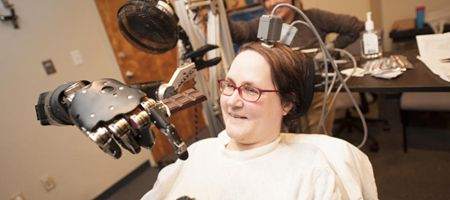With the help of researchers from the University of Pittsburgh School of Medicine and UPMC, a quadriplegic woman has been able to control a robot arm to feed herself chocolate.

Jan Scheuermann, 53, of Whitehall Borough in Pittsburgh, has been able to move an arm, turn and bend a wrist and close a hand for the first time in nine years, thanks to brain-computer interface (BCI) technology.
“One small nibble for a woman, one giant bite for BCI,” she says.
In 1996, Ms. Scheuermann was a 36-year-old mother of two young children and running a successful business when her legs ald arms started to weaken. Two years later, she was diagnosed with spinocerebellar degeneration, in which the connections between the brain and muscles slowly and inexplicably deteriorate.
“Now I can’t move my arms and legs at all. I can’t even shrug my shoulders,” she says. “But I have come to the conclusion that worrying about something is experiencing it twice. I try to dwell on the good things that I have.”
On February 10 this year, two quarter-inch square electrode grids with 96 tiny contact points each in the regions of Scheuermann’s brain that would normally control right arm and hand movement.
“Prior to surgery, we conducted functional imaging tests of the brain to determine exactly where to put the two grids,” says UPMC neurosurgeon Elizabeth Tyler-Kabara.
“Then we used imaging technology in the operating room to guide placement of the grids, which have points that penetrate the brain’s surface by about one-sixteenth of an inch.”
The electrode points pick up signals from individual neurons and computer algorithms are used to identify the firing patterns associated with particular observed or imagined movements, such as raising or lowering the arm, or turning the wrist. That intention to move is then translated into actual movement of the robot arm.
Within a week, Scheuermann could reach in and out, left and right, and up and down with the arm. And after three months, she also could flex the wrist back and forth, move it from side to side, rotate it clockwise and counter-clockwise, as well asnd grip objects.
“This is a spectacular leap toward greater function and independence for people who are unable to move their own arms,” says Professor Andrew Schwartz of Pitt School of Medicine.
“This technology, which interprets brain signals to guide a robot arm, has enormous potential that we are continuing to explore. Our study has shown us that it is technically feasible to restore ability; the participants have told us that BCI gives them hope for the future.”
The next step will be to create a two-way electrode system that can not only capture the intention to move, but will also stimulate the brain to generate sensation, potentially allowing a user to adjust grip strength.
“we’re hoping this can become a fully implanted, wireless system that people can actually use in their homes without our supervision,” says Dr Jennifer Collinger of the VA Pittsburgh Healthcare System.
“It might even be possible to combine brain control with a device that directly stimulates muscles to restore movement of the individual’s own limb.”






